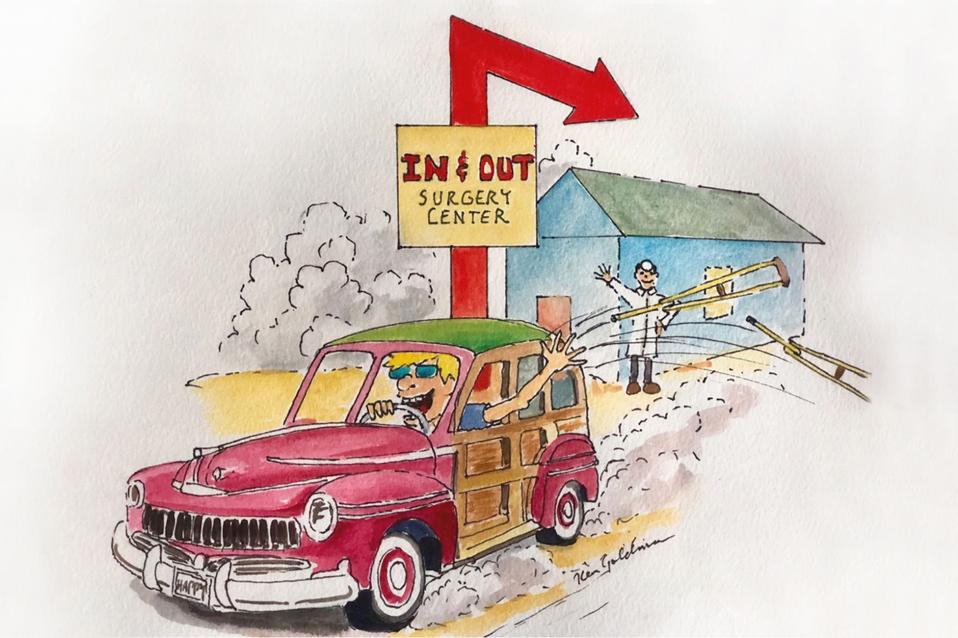Things They Didn’t Teach You in Medical School: Learning from the Burger Pros

Sure, you are a doctor, better yet a surgeon. You’ve spent years in education and training. You are at the peak of your game, the pinnacle of your profession. You eat, sleep and drink medicine.
Speaking of eating, perhaps you can learn a thing or two from a company that serves fast food hamburgers.
A fast food hamburger company? you ask. Yep, fast food burgers.
Of course, not just any burger company. You are the best of surgeons; we wouldn’t want you to learn from anybody but what Money Magazine rated as the 2018 best fast food chain in America.
Perhaps you’ve heard of In-N-Out Burger.
So, what does a renowned fast food burger company have in common with surgeons? What can a surgeon learn about practicing medicine from a company with a 70-year track record of focused achievement in the rough-and-tumble world of retail fast food dining?
As it turns out, a lot.
Let’s start with quality
When the burger pros talk quality, they think of quality in terms of the customer experience.
In-N-Out Burger starts at the beginning. While that may seem to be an obvious place to start, it is often overlooked. For In-N-Out, the beginning is with the ingredients, the uncooked beef, the raw potatoes, the freshly baked buns. The very beginning of a meal. For example, In-N-Out delivers fresh meat to every one of its stores every day. Nothing is frozen.
People are at the beginning as well at In-N-Out. Once hired, employees are carefully trained in the values and techniques of In-N-Out and on the company’s relentless focus on the customer.
Surgeons who operate in ambulatory surgery centers (ASC) likely understand the importance of the beginning of the patient journey through the surgical process. As measured against traditional hospitals, the patient experience at ASCs is far superior as staffs are well trained and efficient. Anesthesiologists trained as outpatient clinicians do not overmedicate, leaving patients feeling better following surgery, resulting in a happier patient and improved outcome. An important byproduct of the focus on the patient experience in ASCs is the markedly lower infection rates among ASC patients compared with those treated in traditional hospitals.
In short, from beginning to end, in hamburgers or surgery, the customer or patient experience is the result of the focused management of a process. For their part, ASCs make every effort to enhance the patient experience. The surgeon must do the same.
Consistency
Of course, the challenge is how to consistently achieve great customer experience, time after time, burger after burger, across a company with thousands of employees serving tens of thousands of burgers.
In-N-Out Burger begins training employees in their “Quality you can taste” philosophy from the moment they are hired. They make sure that everyone who works for them understands the importance of practicing their philosophy and keeping it top of mind every day with every customer.
In short, the burger pros pay attention to their team members. They hire carefully, set expectations at the beginning, stick to their standards and continue to invest in their team members.
ASCs’ consistent patient-first approach to medicine is similar to that of a concierge service company rather than what is common in healthcare – a “you need me” mentality. This consistent experience at ASCs is what patients and surgeons consider a trademark for ASCs.
In-N-Out prides itself on consistency for the simple reason that consistency brings customers back for more. Likewise, with ASCs that practice delivering consistent, high-quality services, surgeons can expect the same high-quality, consistent service for their patients. And like the burger pros, consistent delivery is why ASCs can provide bundled payments in such a reliable, predictable manner.
Competition
In their seminal work The Lessons of History, historians Will and Ariel Durant noted that one of the first lessons of history is that life is competition.
This is something the burger pros well understand. Consider the options a consumer has before them when they think about having a burger for lunch or dinner. It is clearly less understood in healthcare in general and in the hospital setting in particular.
ASCs are a four-decade-old industry compared to hospitals that have been around since the turn of the 20th century. The existence of ASCs is a competitive response to hospitals, with ASCs growing at a faster pace than hospitals due to the intense focus on costs. Just like the burger pros, ASCs understand their cost structure and are intensely focused on managing those costs. Therefore, when teaming up with independent surgeons and anesthesiologists via a bundled payment structure, ASCs are naturally and transparently able to compete versus hospitals.
Hospitals, for a variety of reasons, are significantly challenged to compete against the combination of ASCs and bundled payments. Especially when the ASC, their surgeons and staff affiliates and downstream providers work together to provide the patient with the best possible surgical experience. Rather like the crew at the burger store working together to serve the best hamburgers to their customers.
Loyalty
As Forbes Magazine notes in an October 2018 feature story about In-N-Out Burger, In-N-Out customers have an allegiance to the brand. “They have a loyalty and an enthusiasm for the brand that very, very few restaurants can ever obtain,” says Robert Woolway, who handles restaurant deals for the LA-based investment bank FocalPoint Partners.
And, according to Forbes, that loyalty pays off. “An In-N-Out store outsells a typical McDonald’s nearly twice over, bringing in an estimated $4.5 million in gross annual sales versus McDonald’s $2.6 million. (In-N-Out, which is private, won’t comment on its financials.)”
In-N-Out customers are loyal because they consistently have a great overall experience dining at In-N-Out.
Likewise, surgeons are loyal to ASCs for one simple reason: The experience for the surgeon and their patients is second to none. Patients love the experience, outcomes and lower costs of ASCs. When the patient is happy, so is the surgeon!
Costs
As reported by Forbes Magazine, “McDonald’s and Burger King serve over 80 items; In-N-Out famously serves fewer than 15.”
The big burger chains are rather like hospitals, as they attempt to be everything to everybody. As a result, hospital supply chains are massive, complex, costly and management intensive.
In contrast, ASCs, like In-N-Out, work to keep things relatively simple. Working closely with ASC physician staff and partners they standardize supplies, implants and other costs, making them not only a more competitive but also a more durable business.
Both In-N-Out and ASCs focus on standardized processes. As noted by Forbes, at In-N-Out, “Buns are baked with slow-rising dough each morning. Three central facilities grind all the (never-frozen) meat, delivering daily to the 333 restaurants. Nearly all its locations are in California, and all are company owned. (In-N-Out does not franchise.) Heat lamps, microwaves and freezers are banned from the premises. The recipes for its burgers and fries have remained essentially the same for 70 years.”
Similarly, in a day in the life of an ASC, pre-op teams have the patient ready to go so that when the operating room is ready, the anesthesiologist has the patient completely prepped for surgery. ASC staff work as a team to assist the surgeon to have all equipment and supplies ready and available, opening only requested items to reduce waste. Post-op, the ASC team carefully manages recovery as they begin preparation for the next patient.
Bundled payments
When you know your costs, you can consistently and effectively bundle your services, increasing efficiency and ultimately improving patients’ quality of experience. For the Southern California market, In-N-Out bundles items — such as Combo #1, a double-double, fries and a drink for $6.70 — adding to the customer experience with easy ordering and money savings. In a similar fashion, Global 1, working with ASCs and surgeons, bundles over 100 different surgical case types, offering one price to the patient and the insurance company, and applies savings inherent in bundles to Medicare cases as well.
_____
With over 100 surgery centers and 600 surgeons in the statewide network, the Blue Shield California (BSC)-Global 1 bundled payment program is going strong with many plans to expand.
Scott Leggett is co-principal, Global 1 and managing director, Convergent SameDay Orthopedic Strategies. With more than two decades working in orthopedics, Leggett’s experience includes founding a network of independent, physician-owned outpatient surgery centers. In addition, he served as the president and board member of the California Ambulatory Surgery Association (CASA).
Find Scott on LinkedIn
Global 1, a licensed third-party administrator (TPA), is the largest commercially insured bundled payments manager in California and amongst the largest in the nation. Global 1’s innovative bundled payment structure is designed to deliver cost-effective surgical services that result in increased transparency, lowered costs and improved medical outcomes in an outpatient setting.



